The following analysis of select Montana real estate markets is provided by Windermere Real Estate Chief Economist Matthew Gardner. We hope that this information may assist you with making better-informed real estate decisions. For further information about the housing market in your area, please don’t hesitate to contact your Windermere agent.
ECONOMIC OVERVIEW
Montana added 5,700 new non-agricultural jobs over the past 12 months, representing an annual growth rate of 1.2%. Although Montana’s growth rate is still below the U.S. as a whole, it has picked up a little in recent months with the addition of 4,400 non-agricultural jobs in the second quarter of the year. I still believe that the state will grow employment by 1.2% in 2019. In June, the state unemployment rate was a healthy 3.5%, down from 3.7% a year ago.
HOME SALES
- 1,371 homes sold during the second quarter of 2019 — a drop of 5.3% over the same period in 2018.
- Total sales activity was a mixed bag, with increases in five counties and declines in four. The largest annual increase was in Park County, where sales were up more than 83%. The largest drop in sales was in the very small Broadwater County.
- The number of homes for sale remains well below levels I would like to see. There was an average of 1,570 listings in the second quarter within the counties contained in this report.
- Low inventory levels are holding sales back. I am still hopeful we will see modest increases in the number of homes for sale as we move through the balance of the year. Even so, growth in inventory will remain modest.

HOME PRICES 
- The average home price in the region jumped by a remarkable 25.2% year-over-year to $413,812. The 1.8% increase over the first quarter of this year was more modest.
- In addition to Madison County, Jefferson and Ravalli counties also saw double-digit price increases. Average prices dropped in the rest of the counties contained in this report, with the largest drop in the small Park County. This is a function of the size of the market and the relatively few transactions that occur there.
- Price appreciation was strongest in Madison County, where home prices rose 61%, but I would add that this is a very small area where wild swings in prices are not uncommon.
- The takeaway from this data is that, in aggregate, prices continue to rise but not all markets are created equal.

DAYS ON MARKET
- The average number of days it took to sell a home dropped 15 days compared to the second quarter of 2018.
- Homes sold fastest in Gallatin County and slowest in Madison County. Five counties — Missoula, Lake, Broadwater, Gallatin, and Park — saw days-on-market drop compared to the second quarter of 2018.
- During the second quarter of 2019, it took an average of 110 days to sell a home in the region.
- The takeaway here is that market time has improved compared to a year ago.

CONCLUSIONS
 This speedometer reflects the state of the region’s real estate market using housing inventory, price gains, home sales, interest rates, and larger economic factors.
This speedometer reflects the state of the region’s real estate market using housing inventory, price gains, home sales, interest rates, and larger economic factors.
For the second quarter of 2019, I have held the needle in the same position as last quarter. Mortgage rates continue to be at very attractive levels, which is possibly getting more buyers off the fence. However, inventory limitations persist and that will put additional upward pressure on prices.
ABOUT MATTHEW GARDNER
 As Chief Economist for Windermere Real Estate, Matthew Gardner is responsible for analyzing and interpreting economic data and its impact on the real estate market on both a local and national level. Matthew has over 30 years of professional experience both in the U.S. and U.K.
As Chief Economist for Windermere Real Estate, Matthew Gardner is responsible for analyzing and interpreting economic data and its impact on the real estate market on both a local and national level. Matthew has over 30 years of professional experience both in the U.S. and U.K.
In addition to his day-to-day responsibilities, Matthew sits on the Washington State Governors Council of Economic Advisors; chairs the Board of Trustees at the Washington Center for Real Estate Research at the University of Washington; and is an Advisory Board Member at the Runstad Center for Real Estate Studies at the University of Washington where he also lectures in real estate economics.
 Facebook
Facebook
 Twitter
Twitter
 Pinterest
Pinterest
 Copy Link
Copy Link



